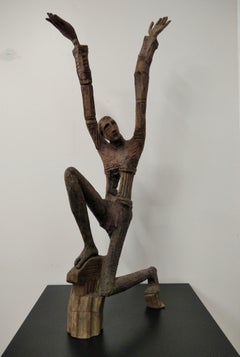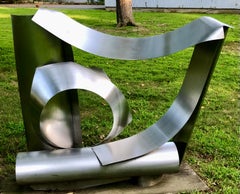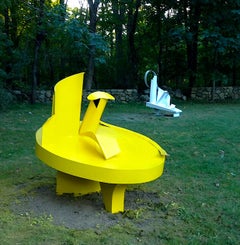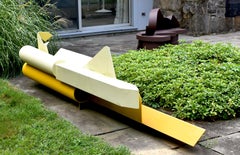1980s Abstract Sculptures
to
32
119
30
31
8
87
Overall Width
to
Overall Height
to
4
11
1,379
8,109
2
2
7
10
11
41
123
203
275
228
110
49
23
6
6
6
4
3
4
2
2
2
1
1
1
1
1
1
1
1
1
1
1
1
150
72
54
46
40
5
4
4
4
3
226
42
Period: 1980s
Protesta social
Located in Barcelona, BARCELONA
Certificate of authenticity Included (issued by gallery)
Category
1980s Abstract Sculptures
Materials
Wood
Sedente con manos arriba
Located in Barcelona, BARCELONA
Certificate of authenticity Included (issued by gallery)
Category
1980s Abstract Sculptures
Materials
Wood
Vibron : steel sculpture
Located in New York, NY
A steel sculpture by Naomi Press. Signed with initials.
Naomi Press is a female abstract sculptor, who was one of the very few women working in large scal...
Category
Abstract 1980s Abstract Sculptures
Materials
Stainless Steel
Untitled I : abstract steel sculpture
Located in New York, NY
Transform any interior or exterior into a truly unique space with the dynamic works of an acclaimed sculptor Naomi Press.
Naomi Press was one of the very few women working in large ...
Category
Abstract Geometric 1980s Abstract Sculptures
Materials
Steel
Head
Located in New York, NY
Mixed media and Painted wood, wall sculpture by Rick Prol.
Category
Contemporary 1980s Abstract Sculptures
Materials
Wood
$15,000
Untitled VI : abstract steel sculpture
Located in New York, NY
Transform any interior or exterior into a truly unique space with the dynamic works of an acclaimed sculptor Naomi Press.
Naomi Press was one of the very few women working in large ...
Category
Abstract Geometric 1980s Abstract Sculptures
Materials
Steel
Untitled II : abstract steel sculpture
Located in New York, NY
Transform any interior or exterior into a truly unique space with the dynamic works of an acclaimed sculptor Naomi Press.
Naomi Press was one of the very few women working in large ...
Category
Abstract Geometric 1980s Abstract Sculptures
Materials
Steel
Untitled IX : large-scale steel sculpture
Located in New York, NY
A large-scale steel sculpture by Naomi Press. Signed with initials.
Naomi Press is a female abstract sculptor, who was one of the very few women working i...
Category
Abstract 1980s Abstract Sculptures
Materials
Stainless Steel
Untitled V : abstract steel sculpture
Located in New York, NY
Transform any interior or exterior into a truly unique space with the dynamic works of an acclaimed sculptor Naomi Press.
Naomi Press was one of the very few women working in large ...
Category
Abstract Geometric 1980s Abstract Sculptures
Materials
Steel
Green Ceramic Woman on a Plate, colorful, abstract
Located in New York, NY
A plate with a green and yellow ceramic woman's body from waiter up attached on it.
Signed and dated verso.
Born in Havana in 1950, Alfonzo w...
Category
1980s Abstract Sculptures
Materials
Ceramic
Summerscale : abstract steel sculpture
Located in New York, NY
Abstract steel sculpture by Naomi Press. Signed with initials.
Naomi Press is a female abstract sculptor, who was one of the very few women working in large scale with steel in the ...
Category
Abstract 1980s Abstract Sculptures
Materials
Stainless Steel
Mujer contorsionada
Located in Barcelona, BARCELONA
Certificate of authenticity Included (issued by gallery)
Category
1980s Abstract Sculptures
Materials
Wood
Diosa ébano
Located in Barcelona, BARCELONA
Certificate of authenticity Included (issued by gallery)
Category
1980s Abstract Sculptures
Materials
Wood
Corredor con pelota
Located in Barcelona, BARCELONA
Certificate of authenticity Included (issued by gallery)
Category
1980s Abstract Sculptures
Materials
Wood
Abstract Figures, Modern Bronze Sculpture by Arturo Di Modica
Located in Long Island City, NY
Arturo Di Modica, Italian/American (1941 - ) - Abstract Figures, Year: 1980-81, Medium: Bronze sculpture, signature, numbering and date inscribed, Edition: 1/1, Size: 55 x 36 x 3...
Category
Modern 1980s Abstract Sculptures
Materials
Bronze
Reclining Figure II, by Allan Houser, Apache, abstract, figurative, bronze
By Allan Houser
Located in Santa Fe, NM
Reclining Figure II, by Allan Houser, Apache, abstract, figurative, bronze
Allan Houser was born in 1914.
His artwork is an ongoing testimony to Native life in America – its beauty...
Category
Contemporary 1980s Abstract Sculptures
Materials
Bronze
OPENING GRANITE
Located in New York, NY
Duality manifests in her work as she juxtaposes rough, jagged edges with smooth, polished surfaces, as well as with the physical structure of the work, has each of the pieces typical...
Category
1980s Abstract Sculptures
Materials
Mixed Media
Price Upon Request
Maqueta Armonía de Volúmenes y Espacios, La Hoyada
Located in Miami, FL
Maqueta Armonía de Volúmenes y Espacios
-La Hoyada- BMPC-002, 1980(1982)
Edition /25
Bronze
48 x 37 x 26 cm
18.8 x 14.5 x 10.2 in.
ABOUT THE ARTIST
Narváez was born in Porlamar, Venezuela, in 1905; he was the fifth son of eleven siblings; his parents were Jose Lorenzo Narváez and Vicenta Rivera. Don José Lorenzo, a multifaceted and creative man, sowed the seed of creativity in his son. “My father did not fit in with his fantasies of cabinetmaker, bricklayer, master builder, and self-taught architect.”1 From an early age, Francis was led to the artistic activity, he traced, carved, made replicas of the furniture and the saints restored by his father.
In 1920 he obtained his first professional assignment, a San Rafael for the Church of Carupano, and, in 1922, his father authorized him to travel to Caracas to pursue his studies as an artist. He studied at the atelier of Marcos Castillo, at of the Angel Cabre y Magriña and at the Academy of Fine Arts in Caracas, where he was introduced to the painters and intellectuals of the time.
In 1928 he presented his first solo exhibition at the Club Venezuela. With the money raised from the sale of the works and the support of Monsignor Sosa, and the Ministers Centeno Grau and Arcaya, he studied in Paris on a scholarship. Once there, he enrolled at the Académie Julian, where Tito Salas, Cristóbal Rojas and Arturo Michelena had also studied. It was in Paris where, unable to work in wood, he turned to stone carving. “In Paris, I didn’t have wood, so I carved a lot in stone (…), when there were demolitions I purchased chunks of stone, I would take them to the workshop and carve them.”2
His first attempts at volumetric sculptures and painting in plain colours, linked to the thematic of American miscegenation and Creole reality, can be traced back to that first trip to Paris. During his stay in the French city, Arturo Uslar Pietri, Alfredo Boulton, and Finita Vallenilla supported the artist both financially and logistically, and in February of 1930, the trio of friends arranged another exhibition for him at the Club Venezuela. Narváez describes his exhibition as follows: “(…) in it I feel that the sculptural work is more my own, done with more assurance, a response to my pursuit of large planes, stylisation and synthesis.”3 By then, as Boulton himself noted in his book about the artist, Narvaez departed from most of the artistic traditions that prevailed by that time in Venezuela.
In 1931 he returned to Caracas and established his atelier at the Barrio Obrero in Catia. The atelier became the hub of the intellectual life of the time. “In those years, the atelier of Francisco Narváez was the hub of the greatest Venezuelan hope. Nothing comparable to it can be found either before or since.”4
From that year onwards, exhibitions, projects, trips, and awards we multiplied. He was awarded the President of the Republic of Venezuela Prize, the National Sculpture Prize of the 1st Official Venezuelan Art Salon, and the John Boulton Prize of the 3rd Annual Venezuelan Art Salon; for the Military Academy, he produced a spectacular relief entitled La Patria.
In 1945, commissioned by the architect Carlos Raúl Villanueva, he produced two groups of sculptures known as Las Toninas, both located in the O’Leary Square. There, as he himself states, he incorporates some baroque patterns into the figures to the source itself: “It is a work of balance between the decorative requirements and the sculpture of planes and angles.”5
In 1948 he was awarded the National Painting Prize. In the same year, he was called upon by the architect Carlos Raul Villanueva to participate in the project for the arts integration in the Universidad Central de Venezuela. Francisco Narváez’s public output continued with works such as the statue of Fermín Toro, La Educación, La Ciencia, three murals (produced by María Luisa Tovar) for the Instituto de Medicina Experimental, El Cristo; el Atleta, the equestrian statue of General Rafael Urdaneta.
In 1953 he was appointed Director of the School of Plastic and Applied Arts, and in July of the same year, he exhibited “Francisco Narváez, Maderas, Piedras y Bronces” (Francisco Narváez, Woods, Stones and Bronzes) at the Museum of Fine Arts.
Narváez is, unquestionably, one of the great Venezuelan sculptors, his work goes through various stages and interests; as the art world evolves, the artist does not remain in his initial scopes of work. His creations are not imposed by the prevailing trends or fashion but do evolve by experimenting with new materials and interests.
When one peruses the artist’s lengthy list of exhibitions, commissions, and awards, it is worth remembering the Narvaez who embark on his career as a child and who, overcoming obstacles, knew how to make the most of his curiosity. He did not settle for living off his successes. He did not remain stagnant as many creators of his environment did. Narvaez managed to understand the changes in the history of art around him. We must not overlook the fact that Francisco Narvaez is an artist amid all the changes occurring in the art world. He moves from the classics to the great transformations in the art world. It is the Europe of Picasso, Braque, Arp. He observes, he is aware of what is happening in the centres of the world of art, but between his craft and his sensitivity, the result is NARVAEZ, his stamp, and his identity.
Francisco Narváez comes from tradition, and his first stage is linked to the classics, to the exploration of his heritage, but always with his very own language. Throughout his prolific career, he knew how to remain true to himself, without disregarding the influences of his surroundings or his artistic interests: his ability as a sculptor, his selection of materials, whether they were wood, stone or bronze; his choice of the subject of his work…His mastery and great craftsmanship are a constant that over time have made him a leading player in the history of contemporary Venezuelan and world art.
From his beginnings, no subject was foreign to him. His paintings, drawings, aquarelles, and sketches are testimony to his prolific output. Among his themes are portraits, our traditions, still lifes, and landscapes. Narváez is an artist who represents his time. Later, he evolved towards purer and simpler forms, abandoning figurative art for short periods.
In 1956 he declared to the newspaper El Nacional: “Every day I am freeing myself, it is a soul that frees itself from the ephemeral wrappings of the circumstantial always, as well as from the inevitable weight of the anecdote. This second stage of my work is remarkably close to abstractionism, even if there are still certain figures or figurations in the sculptures that I will shortly be showing. However, pure, and absolute abstractionism, it will treat the form itself as the sole reason for its existence on the plane of artistic excellence.”6
The artistic development was his professional life. Each period of his life as an artist, he went one step further, searching, solving, seeing plenty of things and understanding how diverse expressions were transforming themselves. His hands followed his gaze and his mind, always inquisitive. He added movement to the volumes.
Arturo Uslar Pietri, “Formas Nuevas”, Cromotip editions, 1956 “Francisco Narváez is a path: the path that Venezuelan sculpture...
Category
Abstract 1980s Abstract Sculptures
Materials
Bronze
Accumulation of Violins, bronze sculpture
By Arman
Located in Long Island City, NY
Accumulation of Violins
Arman, French (1928–2005)
Date: 1989
Bronze, signature and number inscribed
Edition of 37/99
Size: 13.25 x 6.5 x 6.5 in. (33.66 x 16.51 x 16.51 cm)
Category
Pop Art 1980s Abstract Sculptures
Materials
Bronze
Price Upon Request
"Offshoot" minimalist bronze sculpture
Located in Glen Ellen, CA
"Offshoot" is a horizontal pedestal sculpture by renowned Australian artist Clement Meadmore. It is an elegantly simple form with a beautiful dark brown patina. "Offshoot" balances o...
Category
Minimalist 1980s Abstract Sculptures
Materials
Bronze
Price Upon Request
Buffalo Dance, bronze, sculpture, by Allan Houser, brown, casting, Pueblo
Located in Santa Fe, NM
Buffalo Dance, bronze, sculpture, by Allan Houser, brown, casting, Pueblo,dancer
limited edition bronze casting of 20
lifetime casting
Category
Contemporary 1980s Abstract Sculptures
Materials
Bronze
Edgar Negret El Sol Rojo, 1985, Painted Aluminum, 250 x 244 x 80 cm
Located in Miami, FL
Edgar Negret
El Sol Rojo, 1985
Painted Aluminum
250 x 244 x 80 cm
98.4 x 96.1 x 31.5 in.
Carlos Jiménez Moreno, Negret Escultor: Homenaje. Villegas Edito...
Category
Abstract Geometric 1980s Abstract Sculptures
Materials
Metal
Untitled
Located in New York, NY
Beverly Pepper
Untitled, 1982-1983
steel and iron
33h x 27.50w x 10d in
Category
Abstract 1980s Abstract Sculptures
Materials
Steel, Iron
Price Upon Request
Desert Breeze, Sculpture by Allan Houser Haozous, Bronze, Cloaked Figures
By Allan Houser
Located in Santa Fe, NM
Desert Breeze, Sculpture by Allan Houser Haozous, Bronze, Cloaked Figures,Apache
Allan Houser was represented by Glenn Green Galleries (formerly known a...
Category
Contemporary 1980s Abstract Sculptures
Materials
Bronze
The Duck (N.6., No. 3)
By Garth Evans
Located in Austin, TX
Artist: Garth Evans (British, b. 1934)
Title: "The Duck (N.6., No. 3)"
Year: 1982
Medium: Painted plywood wall-hanging sculpture
Signed and titled
Dimensions: 24" x 12" x 7"
Conditio...
Category
Contemporary 1980s Abstract Sculptures
Materials
Plywood, Acrylic
Price Upon Request
Entwined Bodies, Bronze Sculpture by Sophia Vari
By Sophia Vari
Located in Long Island City, NY
Artist: Sophia Vari, Greek (1940 - )
Title: Entwined Bodies
Year: circa 1985
Medium: Bronze Sculpture, Signature and number inscribed with foundry stamp
Edition: 4/6
Size: 12.5 x 2...
Category
Modern 1980s Abstract Sculptures
Materials
Bronze
Price Upon Request
Platter
Located in Kansas City, MO
Artist : Arnie Zimmerman
Title : Platter
Materials : Stoneware, glaze
Date : 1982
Dimensions : 22.75" x 23.5" x 4.5"
Description : Hand-signed and dated o...
Category
Modern 1980s Abstract Sculptures
Materials
Ceramic, Glaze, Stoneware
Price Upon Request
Gree's Head
By Sophia Vari
Located in Long Island City, NY
Artist: Sophia Vari, Greek (1940 - )
Title: Gree's Head
Year: 1985
Medium: Bronze Sculpture, Signature and number inscribed with foundry stamp
Edition: 1/6
Size: 7.25 x 7 x 6 in....
Category
Modern 1980s Abstract Sculptures
Materials
Bronze
Price Upon Request
Cororeol, Polished Bronze Sculpture by Antoine Poncet
Located in Long Island City, NY
Artist: Antoine Poncet, Swiss (1928 - )
Title: Cororeol
Medium: Polished Bronze Sculpture, Signature 'A.P.' inscribed
Edition: 2/6
Size: 41 in. x 21 in. x 5 in. (104.14 cm x 53.34 cm...
Category
Abstract 1980s Abstract Sculptures
Materials
Bronze
Price Upon Request
Plate CR952-W
Located in Kansas City, MO
Peter Voulkos
Title: Plate CR952-W
Medium: Woodfired ceramic
Year: 1989
Signed and dated by the artist
Size: approx. 20.5 x 5 inches
A West Coast potter and sculptor, Peter Voulkos (1924-2002) led in the development of pottery as an art form. . With an MFA from California College of Arts and Crafts (1952), he taught at Black Mountain College (1953) where he was exposed to the avant-garde. In 1954, Voulkos moved to Los Angeles to become the chairman of a newly established ceramics department at the Los Angeles County Art Institute (later renamed the Otis Art Institute) and soon assembled a remarkable group of students: Paul Soldner, Jerry Rothman, Kenneth Price, John Mason, Henry Takemoto...
Category
Post-Modern 1980s Abstract Sculptures
Materials
Ceramic
Price Upon Request
White Marble Abstract Sculpture by Sergio Camargo
Located in Long Island City, NY
Artist: Sergio Camargo, Brazilian (1930 - 1990)
Medium: White Marble Sculpture, signature inscribed on base front
Size: 7.875 x 12.25 x 10.25 inches ; 2...
Category
Abstract Geometric 1980s Abstract Sculptures
Materials
Marble
Wood Fired Platter
Located in Kansas City, MO
Wood Fired Platter
Material: Stoneware and woodfired
Year: 1989
Signed
Dimensions: 3 x 22 x 22"
Provenance - Charles Cowles Gallery, NYC
A West Coast potte...
Category
Abstract 1980s Abstract Sculptures
Materials
Stoneware
Price Upon Request
Mythological Figure (Bone Figure)
By Jim Ritchie
Located in New York, NY
Edition 1/8
Medium: Patinated bronze
Jim Ritchie (1929-2017) born in Montreal, Canada, is known for his pastel drawings and bronze sculptures. He is stylistically linked with Cubism...
Category
Contemporary 1980s Abstract Sculptures
Materials
Bronze
Price Upon Request
Standing and Reclining Figure
By Jim Ritchie
Located in New York, NY
Edition 1/8
Medium: Bronze cast of found, assembled bones. Mounted on marble.
Jim Ritchie (1929-2017) born in Montreal, Canada, is known for his pastel drawings and bronze sculpture...
Category
Contemporary 1980s Abstract Sculptures
Materials
Bronze
Price Upon Request
Portrait
By Jim Ritchie
Located in New York, NY
A unique brass abstract sculpture mounted on a bronze base.
Jim Ritchie (1929-2017) born in Montreal, Canada, is known for his pastel drawings and bronze sculptures. He is stylistically linked with Cubism, Abstract figurative work, and modernism, and the human figure is the subject of much of his work. Ritchie had several exhibitions in Montreal before moving to the small town of Vence in Provence, where he lived and worked for over thirty years. The Adelson Galleries...
Category
Contemporary 1980s Abstract Sculptures
Materials
Brass
Price Upon Request
Recently Viewed
View AllMore Ways To Browse
Fred Cozzens
Fred Dalkey
Frederic Frost
G Stiepevich
George Jan Dispo
Giovanni Da Udine
Hermes In Dallas
Hogarth Times Of Day
Humpty Dumpty Bank
Keith Haring Vivienne
Lorenz E. Griffith On Sale
Louis Mathieu Verdilhan
Marianne Stokes
Marilyn Monroe Golden Dreams
Martha Hayden
Olivier Foss
Peter Liashkov
Peter Max Asia




